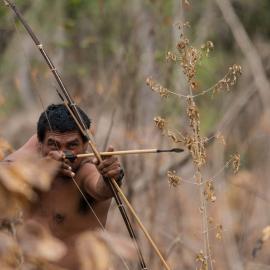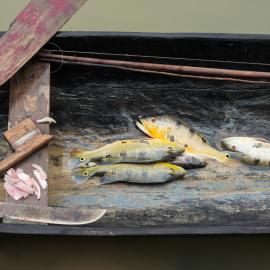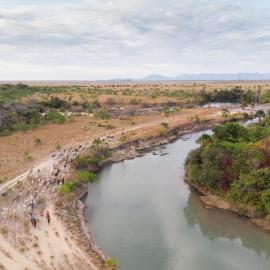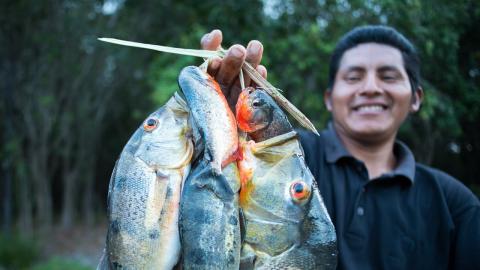Sustainable wildlife management in Guyana
Current initiative
Published
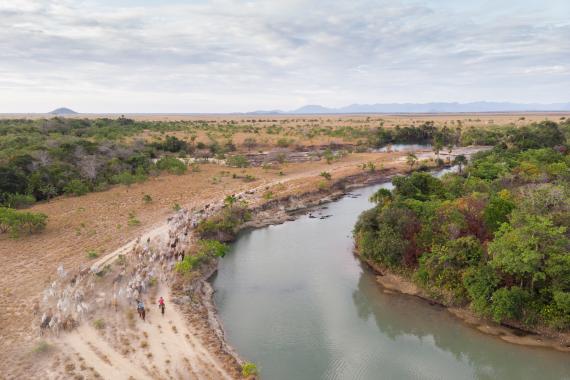
The Rupununi has a history of low-impact, extensive and free ranging cattle ranching. Credit: FAO / David Mansell-Moullin
The sustainable wildlife management (SWM) Guyana programme seeks to ensure that the Rupununi region can continue to offer sustainable options for food security and livelihoods in accordance with traditional lifestyles, while maintaining healthy fish and terrestrial wildlife populations at the landscape level. It has been locally recognised since the early development of the programme that the sustainable use of wildlife in the Rupununi will only be possible if action is taken to reduce the illegal wildlife trade.
Lead
Location
The Rupununi region consists mostly of large tracts of primary forest, with about 20% of its land area covered by natural neotropical savannah and seasonally flooded wetlands. The region is an ecologically sensitive landscape that connects two major river systems and includes two protected areas: the Iwokrama International Centre for Rainforest Conservation and Development and the Kanuku Mountains National Park. The Rupununi is considered the ‘Land of Giants’ for its reputation of supporting healthy populations of large-sized species.
The region is home to approximately 24,000 inhabitants, where indigenous groups maintain traditional lifestyles of subsistence hunting, fishing and farming.
The poaching and wildlife trade problem
Species affected Agouti Dasyprocta leporina , Tapir Tapirus , Jaguar Panthera onca , Birds , Reptiles
Products in tradeLive animals, skin, Jaguar teeth and meat
Overview of the problem
Wildmeat and fish trade
Commercial hunting within national boundaries is currently unregulated. While most of the hunting for meat is currently for subsistence purposes or local markets, the influx of external hunters from the coast who illegally hunt in indigenous lands is perceived as a big threat and source of conflict. Illegally hunted wildmeat is transported to the coast to feed the national demand in urban areas and mining hubs or carried to neighbouring countries where wildmeat is sold at a higher price. Species in demand include tapir, white-lipped peccary, iguana, capybara, caiman, turtles and tortoises.
Fish species with high commercial value, such as the arapaima are also illegally targeted for the Brazilian markets. Although in 1952 the Fisheries Act prohibited the capture of arapaima, the practice in the Rupununi was unaffected. Poaching continues despite the implementation of a management plan for the arapaima.
Illegal wildmeat and fish traders are often urban dwellers from the coast or from Lethem with connections to Brazil, who illegally hunt and fish within indigenous lands or in ranches. Locals are involved as short-term guides, but no permission is sought from local indigenous authorities nor from ranch owners. Despite internal rules, indigenous guides accept the work as a quick source of income.
Pet and skin trade
Guyana is one of the largest exporters of wild-caught animals in South America and the Rupununi is one of the main sources in Guyana. Species traded from the Rupununi include parrots, macaws, parakeets, songbirds, reptiles, arthropods and jaguars.
The main export markets are Mexico, Singapore and the USA. The full extent of the illegal trade is not known, but permeable borders mean illegal trade across Brazil, Venezuela and Suriname is common.
Intermediaries involved in the illegal pet and skin trade are often urban dwellers from Lethem or the coast who deal with traders in cities or in neighbouring countries. Community members may be involved as trappers or hunters, contributing to both legal and illegal wildlife trade, sometimes without knowing if it is one or the other. Trapping and hunting is a competitive source of income locally, although this never been financially quantified.
The anti-IWT initiative
The SWM Guyana programme seeks to ensure that the Rupununi region can continue to offer sustainable options for food security and livelihoods in accordance with traditional lifestyles, while maintaining healthy fish and terrestrial wildlife populations at the landscape level. The programme builds upon existing community-driven initiatives and is implemented through active partnerships with local organisations and indigenous groups.
Acknowledging the complexity of achieving positive outcomes that work both for people and wildlife, the programme is based on a multiple entry approach that combines:
- Revising legal frameworks to ensure clarity, reduce gaps and overlaps, ensure that regulations on wildlife use are harmonised across sectors, and promote integration of national and local efforts to reduce unsustainable use
- Supporting existing community driven efforts to manage wildlife and reduce threats to wildlife
- Supporting locally adapted initiatives to increase access to domestic sources of meat that can support food security
- Ensuring that wildlife and wildmeat markets operate within the legal boundaries and do not lead to unsustainable use
The programme takes a Community Rights-based Approach (CRBA). This means putting people’s rights at the centre of wildlife management. To achieve this objective, the CRBA places a strong emphasis on aspects that are key to achieving sustainable development goals, such as public participation and gender equality. CRBA ensures the right to self-determination and the right to Free, Prior and Informed Consent (FPIC). By recognising the rights of indigenous people and local communities as owners and managers of their customary territory, FPIC support the realisation of this right as well as of other rights in assuring them a decisive voice at every stage of development planning and implementation of any projects that affect them.
The SWM Guyana programme strategy has a multiple entry approach at local, regional and national levels.
At the national and regional level, and in close coordination with the GWCMC and local communities, the programme is currently analysing the legal and illegal wildlife/wildmeat trade chains to understand the actors involved, the trade routes, the economic importance of this trade and the impacts of the trade on wildlife. In addition, the programme is supporting the GWCMC to ensure that new hunting and trade regulations are aligned with local ecological and social realities.
At the local level, the programme is supporting locally driven initiatives that contribute to reduce illegal trade. The South Rupununi District Council has put in place a wildlife committee in charge of responding to wildlife issues in indigenous lands. As part of the committee activities, the following activities have been undertaken:
- Monitoring of illegal wildlife trade using modern technology
- Implementation of environmental education campaigns to inform about the impacts of illegal and unsustainable wildlife trade
- Monitoring wildlife population in key and culturally important sites
- Supporting community councils for the development of hunting rules following the Wapichana Development plan
The programme is also working closely with Caiman house, a local indigenous NGO, to reduce illegal trade for reptiles. The activities include:
- Turtles: Monitoring turtle populations, protecting hatching sites, increasing turtle survival in ex-situ hatching sites, monitoring consumption and trade
- Caimans: understanding human conflicts with caiman and monitoring caiman populations
The whole philosophy of the programme is to support existing local organisations in the Rupununi with funding, network opportunities, organisational capacities and technical skills. In addition, the programme has a very important environmental education component and works closely with the North Rupununi District Development Board and the South Rupununi Conservation Society to implement an environmental education plan, based on a curriculum specifically designed to tackle wildlife issues as perceived by local communities.
The strategy
Strengthening disincentives for illegal behaviour
Increasing incentives for wildlife stewardship
Decreasing the costs of living with wildlife
Increasing livelihoods that are not related to wildlife
Build/and or support sense of community ownership or stewardship
Improving education and awareness
Has the initiative made a difference?
The programme has put in place a monitoring and evaluation process to measure progress and impact. Early results include re-motivated local community members interested in wildlife issues and given a new wind of hope to locally led structures. In addition, highly increased collaboration, sharing and trust across locally led organisations and between them and governmental institutions has been observed.
Other results:
- Wildlife use guidelines defined in 7 pilot communities
- The programme has raised awareness on the fisheries management plan in 20 communities
- The Rupununi Livestock Producers association has supplied over 15,000 chicks to 12 farmers alongside feed
- Over 300 children from 14 communities participation in environmental education activities every year
What works and why
The early successes of the programme is based on three key elements:
- Transparency and trust between the programme, the government and local community organisations
- An in-depth understanding of local motivations, dreams and plans for the future, to ensure that activities are aligned with already existing efforts
- Strengthening of existing locally led institutions instead of creating programme related structures that would not be sustainable after the end of the programme
Factors for success
Supportive national policy/legislation for devolved governance of natural resources
Supportive national policy/legislation on sustainable use of natural resources
Long-term donor support that is flexible, adaptive and/or based on realistic time goals
Supportive, multi-stakeholder partnerships with a shared vision
Sufficient time investment in building relationships and trust between the initiative and local communities
What doesn’t work and why
Too early to assess.
Organisers, donors and partners
The SWM Guyana Project activities are part of the SWM Programme, which is an initiative of the African, Caribbean and Pacific (ACP) Group of States. It is being funded by the European Union through the 11th European Development Fund (EDF). The Programme mobilises an international group of partner organisations with experience and expertise in wildlife conservation, food security and policy development. It is implemented through a consortium partnership, which includes the Centre for International Forestry Research (CIFOR), the Food and Agriculture Organization of the United Nations (FAO), Wildlife Conservation Society (WCS) and the French Agricultural Research Centre for International Development (CIRAD).
For further information contact (peoplenotpoaching@gmail.com).
